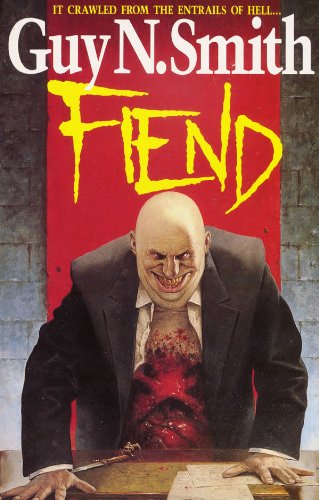
“Fiend” is a horror novel by Guy N. Smith, published in 1988. It’s one of Smith’s many works in the horror genre, known for its blend of suspense, supernatural elements, and grisly imagery.
Plot Summary
“The Ultimate Evil” plunges readers into a world shrouded in darkness and decay, where the chilling silence of a news blackout sets the stage for an event of unparalleled magnitude—the death of the Russian leader. As the slowly decaying corpse lies in state within the confines of the Kremlin, an aura of unreality descends upon the scene, amplifying the sense of foreboding that permeates the air.
Amidst this atmosphere of dread and uncertainty emerges the Fiend—a spectral figure cloaked in a darkness blacker than the deepest shadows. With the stench of putrefaction clinging to its form and an aura of coldness that surpasses even the icy wastes of Siberia, the Fiend embodies the very essence of malevolence incarnate.
Its lips contorted into a bestial snarl and its sunken eyes fixated in a vacant stare, the Fiend’s presence is a harbinger of doom, a primal force that defies comprehension. Yet, as its powerful chest heaves with the effort of drawing breath once more, a chilling realization dawns—the Fiend is not merely a specter of death, but a creature reborn, learning to live again in a world gripped by darkness and despair.
In “The Ultimate Evil,” author [Author Name] crafts a narrative that transcends the boundaries of conventional horror, weaving a tale of existential dread and unfathomable terror. With each page, readers are drawn deeper into a realm where the line between life and death blurs, and the ultimate battle between good and evil unfolds in all its ghastly splendor.
As the Fiend’s presence looms larger and the stakes escalate to dizzying heights, “The Ultimate Evil” delivers a spine-tingling exploration of the darkest recesses of the human psyche. With its masterful prose and relentless pacing, this gripping tale leaves an indelible mark on the imagination, reminding readers that in the face of true evil, survival is not guaranteed, and redemption may be but a distant hope.
Themes and Style
- Supernatural Horror: “Fiend” explores themes of the supernatural, with the monstrous fiend serving as the central antagonist of the story.
- Atmospheric Setting: Smith creates a dark and foreboding atmosphere within the village, with its shadowy streets and isolated cottages adding to the sense of terror and unease experienced by the characters.
- Action and Suspense: The novel is characterized by its fast-paced plot and suspenseful encounters with the fiend, keeping readers on the edge of their seats throughout.
Reception
“Fiend” received generally positive reviews from readers and critics, who praised its atmospheric setting, gripping plot, and memorable characters. The novel’s blend of horror and suspense resonated with audiences, making it a standout entry in Smith’s bibliography.
Author Background
Guy N. Smith (1939-2020) was a British author known primarily for his horror fiction. With over 100 novels to his name, Smith’s works often feature elements of the supernatural, the macabre, and the grotesque. He gained widespread recognition for his “Crabs” series, which became a cult classic among horror enthusiasts.
Legacy
“Fiend” remains a classic example of Guy N. Smith’s talent for crafting chilling and atmospheric horror narratives. While it may not be as well-known as some of his other works, it offers readers a compelling journey into the realm of supernatural terror, showcasing Smith’s ability to create suspenseful and unsettling storytelling.
During the 1980s & 1990s I became friendly with the late Craig Thomas, author of ‘Firefox’ (filmed and starring Clint Eastwood) and several other spy thrillers. Jean and I used to visit Craig and his wife Jill whenever we were in the Lichfield area.
Craig was keen for me to write a thriller and in the late 1980s I conceded to his persuasion and wrote ‘Fiend’. In this instance I had to combine it with a horror theme or else my publishers at that time (Sphere) would not have been interested.
It is set in the Kremlin prior to an important conference in which the Russian leader’s presence is vital. Unfortunately the latter had died shortly before. The Soviets were in a state of panic and as a last resort they sought the help of a black magician to raise him from the dead, which he did successfully.
The outcome was an undead leader exerting his evil power over the Soviet delegation but not as they had planned!
I was rather shocked by the gory cover of the book but it proved its worth, the first printing selling out and going to a reprint.
In a strange way ‘Fiend’ reflects President Brezhnev’s final days. In March 1982 it was reported by U.S. intelligence that Brezhnev had suffered a stroke while making a four-day trip to Tashkent, but there was a cover-up. The Kremlin denied that he was gravely ill but just ‘on his regular winter rest!’ Brezhnev managed to hang on to power until his death eight months after he had fallen ill.
Truth is, as the saying goes, stranger than fiction.
Several of my books have been pirated in Russia but I doubt whether these underground ‘publishers’ would risk issuing ‘Fiend’. They would probably be sentenced to a long stay in Siberia!
Guy N. Smith